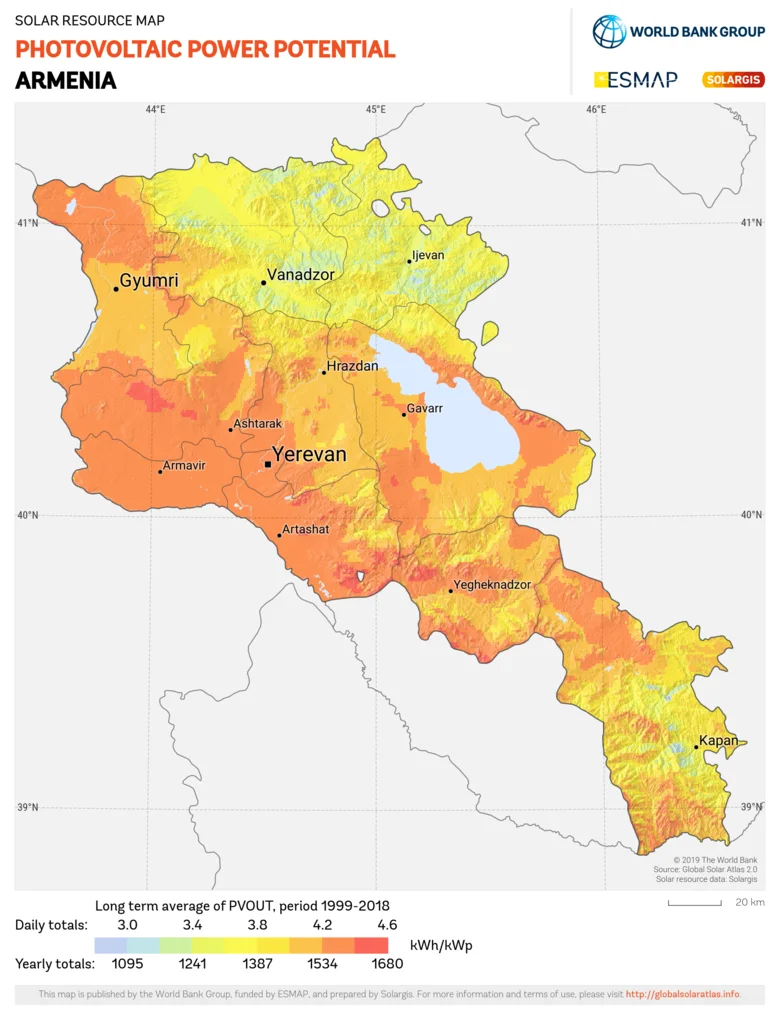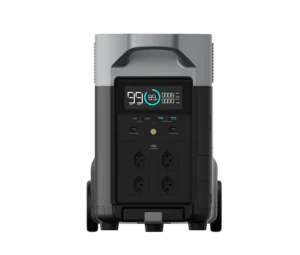Understanding Solar Yield Factors.
Solar yield, or the amount of electricity produced by a solar PV system, is influenced by various factors categorized into three major groups:
1. Climate Factors:
- Solar Irradiance is the amount of sunlight energy available for conversion into electricity, influenced by local climate conditions. According to the global horizontal solar irradiation map of Armenia, the sun energy falling on 1 square meter of horizontal plane is estimated to be between 3.47 and 4.56 kW/m2 annually.
- Temperature: Ambient temperature affects solar panel efficiency, with higher temperatures leading to decreased efficiency.
- Seasonal Variations and Weather Patterns: Changes in sunlight intensity, daylight hours, and weather conditions impact energy generation.
- Terrain Elevation: Higher elevations mean less air obstructing the sunlight’s path, resulting in more direct exposure to sunlight. Consequently, this increased exposure enhances energy capture efficiency and yields higher solar yields.

2. Roof-Specific Factors:
- Tilt and Orientation: Sub-optimal tilt and orientation of solar panels can decrease energy capture efficiency. Losses due to sub-optimal tilt angles may generally range from 5% to 15%, while losses due to sub-optimal orientation may range from 2% to 10%, depending on the degree of deviation. Addressing these factors during a solar PV system’s design and installation phases is crucial for maximizing energy generation and optimizing solar ROI.
- Shading: Obstructions such as buildings, trees, or nearby structures may cast shadows on the roof, reducing sunlight exposure to solar panels. Mitigating shading effects through proper site assessment and system design is essential for maximizing solar energy capture.
- Micro-inverters: Micro-inverters are ideal for mitigating the impact of non-optimal tilt, orientation, or shading on solar panels. Unlike traditional string inverters, micro-inverters are installed on each panel, allowing for individual panel optimization and minimizing losses due to sub-optimal conditions. This can improve overall system performance and higher energy yields, enhancing solar ROI.
3. Equipment-Specific Factors:
- Panel Quality and Efficiency: Solar panels’ quality, efficiency, and degradation rate influence energy generation and long-term performance.
- Inverter Efficiency: The efficiency of inverters impacts overall system performance and energy yield.
- Balance of System Components and System Design: The selection and quality of components and the design and configuration of the solar PV system influence energy production efficiency.
Calculating Solar ROI and Payback Period.
Return on Investment (ROI) and Payback Period are essential metrics for assessing the financial viability of solar energy investments.
ROI calculation:
Return on Investment (ROI) is a financial metric used to evaluate the profitability of an investment relative to its cost. The ROI formula for solar energy investments can be expressed as follows:
ROI = (Annual Solar Yield * Electricity Yield) / (Full Installation Cost)
Where:
- Annual Solar Yield (kWh) represents the total electricity produced by the solar energy system over a year.
- The average Electricity Rate (AMD/kWh) is the average price per kWh of electricity consumed.
- Full Installation Cost (AMD) refers to the total upfront cost of purchasing and installing the solar energy system, including equipment, labor, and additional expenses.
As defined by Armenian legislation, Net metering is a billing arrangement that allows solar energy system owners to receive credits for excess electricity generated by their system and exported to the grid. These credits can offset electricity purchases from the grid when solar production is lower than consumption. When calculating ROI, it is assumed that all kWh generated by the solar energy system is consumed at the average electricity rate, considering the net metering arrangement.
Payback Period Calculation:
The payback Period is the time it takes for the initial investment in a solar energy system to be recouped through energy savings. To calculate the payback period, you would typically replace the numerator with the installation cost and the denominator with the annual savings or revenue generated from the solar installation.
PayBack = (Full Installation Cost)/(Annual Solar Yield * Electricity Yield)
Comparing Solar Investment to Bank Deposits in Armenia.
- On approximately 76% of Armenian lands suitable for solar panel installation, each installed 1 kW of capacity can generate between 1,460 to 1,533 kWh per annum.
- At the average electricity rate in Armenia for consumers using up to 200 kWh per month, the annual savings could be 60,587-66,665 AMD.
- The solar panel installation cost at R-Fab is 400,000 AMD per 1 kW.
Using all this data, we can easily calculate Armenia’s solar ROI, which ranges from 15.15% to 16.67%.
Comparing solar ROI with the maximum rate of bank deposit in Armenia, around 11%, investing in solar energy presents a 50% higher ROI, making it an option for individuals and businesses seeking to diversify their investments and contribute to sustainable energy practices.
Leveraging bank loans can increase ROI. Remember to ask our team about bank loan options.
Conclusion:
Maximizing solar ROI and achieving a favorable payback period is crucial for ensuring the financial success of solar energy investments. A reputable solar installer will model your solar station to simulate the yield accurately and provide a detailed calculation of savings and installation costs.
At R-Fab, we prioritize precision and efficiency in our solar engineering processes. Utilizing premium solar engineering software such as Scanifly and PVsyst, we ensure that your preliminary project with all necessary data is provided the same day we visit the site for inspection. With our expertise and dedication to quality, we aim to maximize the return on your solar investment.
